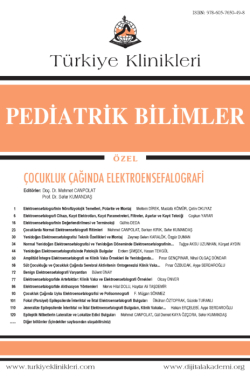Electroencephalography Reporting
Kürşat Bora ÇARMANa
aÇocuk Nörolojisi BD, Eskişehir Osmangazi Üniversitesi Tıp Fakültesi, Eskişehir, TÜRKİYE
Çarman KB. Elektroensefalografi raporlama. Canpolat M, Kumandaş S, editörler. Çocukluk Çağında Elektroensefalografi. 1. Baskı. Ankara: Türkiye Klinikleri; 2019. p.173-6.
ABSTRACT
Electroencephalography (EEG) is an important examination used in the evaluation of many central nervous system diseases, especially epilepsy. The EEG report is the summarization of evaluated EEG. Record features should be defined objectively, and a standard and understandable language should be used. No medication or treatment recommendations should be made from the records.
Keywords: Electroencephalography; report; children
×
Kaynak Göster
Referanslar
- Scher MS. Pediatric neurophysiologic evaluation. In: Swainman KF, Ashwal S, Ferriero DM. Schor NF, eds. Swainman's Textbook of Neurology. 5th Swainman's Textbook of Neurology. 5th ed. Philadelphia: Elsevier Saunders; 2012. p.185-233.
- Kaplan PW, Benbadis SR. How to write an EEG report: dos and don'ts. Neurology. 2013;80(Suppl 1):S43-6. [Crossref]
- Tatum WO, Olga S, Ochoa JG, Munger Clary H, Cheek J, Drislane F, et al. American Clinical Neurophysiology Society Guideline 7: Guidelines for EEG reporting. J Clin Neurophysiol. 2016;33(4):328-32. [Crossref] [PubMed]
- Flink R, Pedersen B, Guekht AB, Malmgren K, Michelucci R, Neville B, et al. Guidelines for the use of EEG methodology in the diagnosis of epilepsy. International League Against Epilepsy: commission report. Commission on European Affairs: Subcommission on European Guidelines. Acta Neurol Scand. 2002; 106(1):1-7. [Crossref] [PubMed]
- Türe HS, Akhan G. [Assessment and reporting of electroencephalography]. Turkiye Klinikleri J Neurol-Special Topics. 2017;10(2):212-6.
- Holmes GL. Generalized seizures. In: Swainman KF, Ashwal S, Ferriero DM. Schor NF, eds. Swainman's Textbook of Neurology. 5th Swainman's Textbook of Neurology. 5th ed. Philadelphia: Elsevier Saunders; 2012. p.741-2.

